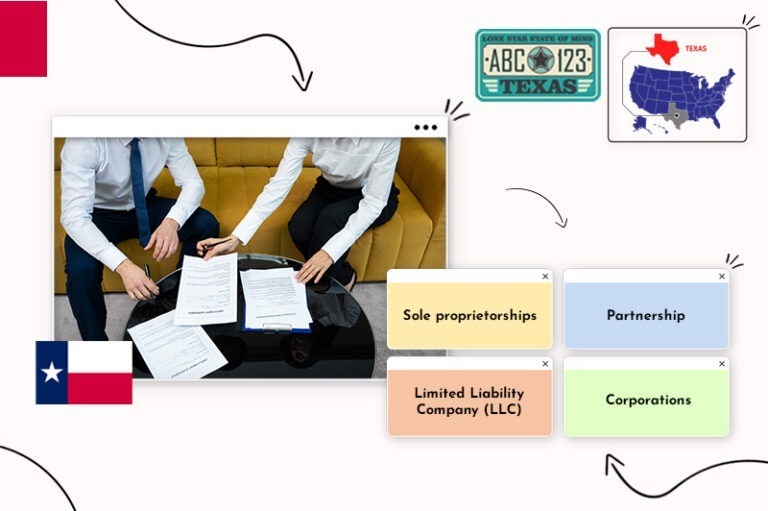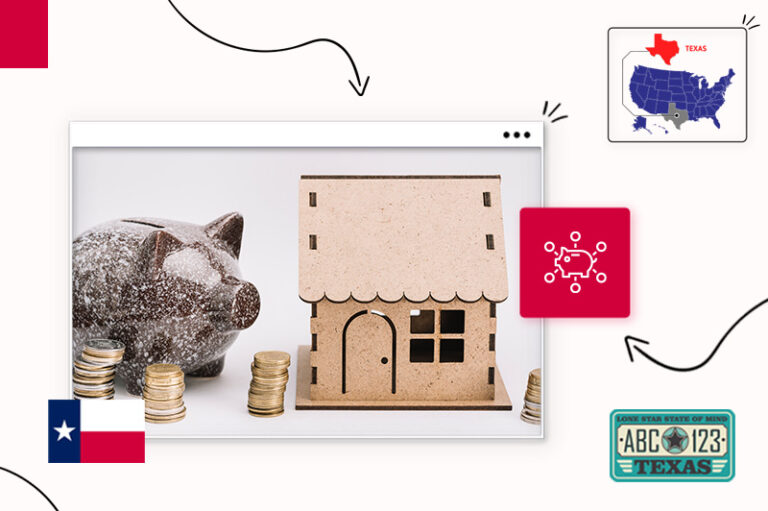

With no corporate or personal income tax, an economy ranking 9th in the world, and numerous small business government incentives, starting a business in Texas is an excellent decision.
But people don’t live in Texas to work; they work to live in Texas and enjoy a 1st class lifestyle.

Easily form your LLC with Tailor Brands
Home » How to Start a Small Business » Start a Business in Texas
Texas has affordable living costs, high-quality education, and a vibrant culture with diverse cities, state parks, rodeos, live music, museums, art galleries, wineries, and a vast cuisine.
No wonder Texas is the #1 state to do business in, according to Chief Executive Magazine.
But if you’re fixin’ to start a business in Texas, you can’t be all “hat and no cattle.”
You must follow state regulations for licenses and permits, taxes, and hiring employees. And choose a viable business idea, business name, and the right location to fulfill your Texan entrepreneurial dreams.
In this post, I’ll tell you how to start a business in Texas that’ll have you busier than a hound in flea season:
Here are the steps you need to follow to start a business in Texas:
“If that ain’t a fact, God’s a possum.”
The first step in your entrepreneurial journey is choosing your business idea.
To choose one that has you running with the big dogs, consider these 3 things:
Brick-and-mortar entrepreneurs should also choose a business idea that suits Texas because you can tap into a lucrative market.

Texas is famous for many things, like the Alamo, BBQ, football, Longhorns, and Texas slang.
And one phrase sums up why you need a business plan:
“She’s itching for something she won’t scratch for.”
Which means dreaming of something too big!
Your business plan ensures your idea isn’t a dream and conveys your vision to those you need to make it a reality.
It does this by validating your idea, setting goals, creating timelines for achieving them, and convincing others to invest.
Here are the 3 key components of a well-written business plan:
When fixin’ to start a business in Texas, you must research your marketplace, target audience, and competitors to validate your idea.
You do that by asking and answering these questions:
You can then use your answers to create financial projections and a marketing plan.
A financial plan forecasts your future credits and debits to ensure you have enough cash to start and run your business.
Your plan also predicts your break-even point (when you’ll make a profit) so you can determine if you’ll need a loan.
It also provides projections so lenders can assess whether you’re a safe bet.
A financial plan must include:
Your business idea might be the “best thing since sliced bread,” but no one will know about it without a market strategy.
Here’s where you research your target market to find where and how consumers shop for what you’re selling. And you’ll run a competitive analysis to see which marketing strategies your competitors use.
The results will tell you what marketing strategies to invest in and where to promote them.
Online business owners have it easy.
You can choose a business-friendly and culturally vibrant location and enjoy the perks without worrying about foot traffic.
But location is everything for businesses that rely on passing traffic, like beauty salons, restaurants, and retail!
If that’s you, choosing the right location doesn’t have to be as challenging as putting socks on a rooster.
Just ask yourself the following questions:
Zoning laws control how we use properties for business, such as not allowing an adult bookshop next to a school or a factory in a residential area. Business owners must apply for zoning permits to run their businesses in a specific location.
Zoning laws are location specific, so contact your county clerk’s office or visit your local government website for more information.
Or, you can look on the Texas Economic Development & Tourism’s Business Permit Office (BPO) website or download the Texas Business Licenses & Permits Guide.
Now, you must decide whether you are an online-only business, a brick-and-mortar business, or both.
You can start from one and expand later, so keep that idea on the back burner.
To launch an online business, you’ll need a few key elements:

Your next step is to choose a business name that’s catchy and easy to remember. And it can’t be as common as cornbread; it must represent what your business offers and stands out in your industry to grab your audience’s attention.
Here are a few things to consider:
To come up with ideas, you can get creative with wordplay and combinations of words or use online name generators like Naminum and Panabee.
You can also use free tools to see how your name would look as a logo or on your packaging.
Texas naming laws and regulations:
Texas has specific rules for registering a business name.
Sole proprietors, partnerships, and even LLCs who want to use a different business name can register a Texas Doing Business As (DBA) on the state’s online business services SOSDirect website.

Business structures come in two forms, formal and informal.
Formal structures like LLCs and corporations are separate entities from their owners and provide liability protection.
Informal structures like general partnerships and sole proprietorships aren’t separate and offer no liability protection, meaning your assets are at risk of lawsuits and creditors.
Your structure choice often depends on your business type, liability exposure, if you’ll have employees, and need funding.
Some business structures are free to start, while others have registration fees and annual state franchise tax.
An informal, unincorporated structure with no separation between the business and the single owner who receives all profits and financial liabilities.
A partnership is like a sole proprietorship, informal and unincorporated, but with multiple owners.
A formal, incorporated structure that combines a sole proprietorship’s flexibility and a corporation’s liability protection. Most small businesses choose the LLC structure for easy maintenance and favorable tax.
A separate legal entity that provides liability protection to its shareholders. It has more regulations and tax advantages than an LLC and is more popular with investors.
Learn more about forming an LLC in Texas in our step-by-step guide.
An informal, unincorporated structure with no separation between the business and the single owner who receives all profits and financial liabilities.
A partnership is like a sole proprietorship, informal and unincorporated, but with multiple owners.
A formal, incorporated structure that combines a sole proprietorship’s flexibility and a corporation’s liability protection. Most small businesses choose the LLC structure for easy maintenance and favorable tax.
A separate legal entity that provides liability protection to its shareholders. It has more regulations and tax advantages than an LLC and is more popular with investors.
Sole proprietorships and partnerships can file a (DBA or assumed name) with their local county clerk’s office. LLCs and other incorporated business structures register via the Texas Secretary of State’s Office (SOS) website.

All successful businesses have one thing in common.
Good bookkeeping.
Here’s the thing: it’s easy to do right and often a costly nightmare when done wrong.
Good bookkeeping means balancing your financial records. In layperson’s terms, that means adding up your credits (what you earn) and subtracting your debts (what you spend) monthly.
After that, it’s easier for your accountant to determine your final net profits and tax liability.
Business bank accounts, credit cards, and accountants have other benefits, too, so let’s see why you need them:
Most Texas banks require you to have an EIN to open a business bank account, so sole proprietors and general partnerships should consider getting one.
The job of an excellent accountant is to reduce your tax bill using relative tax deductions while ensuring you stay within local, state, and federal tax laws.
An accountant can only do this when you provide accurate bookkeeping, debits and credits, invoices, and receipts.
You can provide those using accounting software that links to your business bank account and credit card and lets you send invoices and monitor payments.
If those are beyond your current budget, an Excel sheet with columns for debits, credits, and monthly (auto sum) calculations can do the trick.

Most start-ups need funding; the difference between them is how they get it and at what cost.
For example, small business funding options include:
Fortunately, Texas offers county grant/loan incentives and other small business funding options.
The SBA is an independent federal agency that supports small businesses through SBA-approved 3rd party business loans. Some loans include:
For more information about SBA loans, visit the SBA.gov website and the Texas government department of Finance and Capital for small businesses.
The CUOT (credit union of Texas) provides fixed and variable low-interest, fixed small business loans, commercial mortgages, credit cards, and credit lines.
Small business owners can apply for Texas business incentives, like tax credits and grants; here are some places to look:
You can also contact the Governor’s Small Business Assistance team at [email protected] for further information on small business resources.
Your next step in starting a business in Texas is getting insurance.
The cover you need depends on your business, daily operations, whether you’ll have employees, or your willingness to work without it.
Here are the 5 most common types of business insurance:
There’s no Texas law saying you must have business insurance unless you have employees:

You don’t need a general business license in Texas. Still, you might need specific permits or licenses at the local, state, and federal levels.
Further information is available by downloading the Texas Business License and Permit guide.
If you have questions about licenses or permits, you can email the Business Permits Office.
Most businesses pay self-employment and a progressive federal income tax to the IRS.
Businesses with employees must also withhold 7.47% of their employee’s paycheck to cover (Medicare and Social Security), paying an equal percentage to the Internal Revenue Service.
Texas does not impose a corporate income tax. Instead, Texas imposes a franchise tax (an annual fee for doing business in a state or city) on incorporated companies like LLCs. Sole proprietors are exempt from the franchise tax.
You can see what sales tax your location charges by visiting the Comptroller.Texas.gov website.
Most folks need clarification on federal, state, and local taxes; fortunately, Texas is tax-friendly.
For example, business taxes are low, the state doesn’t impose a personal income tax, and businesses with profits under the Texas no-tax-due threshold pay no franchise tax.
Contact your county appraisal district and tax office for specific information on Texas business taxes.
And these FAQ Videos on Texas business taxes answer most questions regarding tax laws.

No matter how brilliant your business idea is, you need the right people to help you reach your full potential.
Even if this isn’t your first rodeo, and you plan on going solo, having a team to rely on is crucial to starting a successful business in Texas.
Complying with Texas hiring requirements and payroll regulations are just as important.
Let’s look at the people first:
Happy employees make happy customers, and happy customers make happy business owners.
Simple and true.
After all, your employees are the face of your business; they’re responsible for delivering to your clients, meeting deadlines, and running your daily operations.
So, it’s no exaggeration to say the people you employ or surround yourself with can make or break your business.
And it’s not only your employees; those you hire part-time and take advice from are equally important.
This includes the freelancers you use for outsourcing, experienced accountants on retainers, and fellow business owners within your network.
Remember, to be successful, hang with those who already are.
To hire employees in Texas, you must comply with payroll regulations and register with specific government departments.
So, before you conduct interviews, visit the Texas Businesses and Employers webpage and learn about state and federal employer requirements.
And take the following steps:
Once you’ve found your team and learned how to file your payroll taxes, consider using a payroll service to record employees’ hours, issue paychecks, and simplify your tax returns.
Contractors are great news for start-ups because you can hire them for specific tasks on a need-only basis, save cash on employee costs like insurance and payroll taxes, and use their experience to drive your business forward.
And you can use them for anything, from content marketing to project management.
But you must hire your contractor correctly to avoid violating employment laws.
How to hire contractors in Texas:

You know the movie “Field of Dreams” with Kevin Costner? And those famous words “build it and they will come”?
Well, here’s the thing, that only works in movies. No one will come knocking on your door or website without marketing.
But few new business owners know which marketing strategies to use, so they often opt for the spaghetti and wall technique, using everything to see what sticks!
Other start-ups have small marketing budgets.
Thankfully, the six most powerful marketing strategies are free; you don’t need previous experience, and they’re all as handy as a latch on an outhouse door!
People are creatures of habit, and when we find something that works, we often stick with it.
And that’s a problem for your new business.
You’ll need some honey to attract prospects to your honey pot, i.e., special offers.
Some ways to get people buzzing are:
You know the saying, “You scratch my back, and I’ll scratch yours,” that describes brand collaboration.
It’s all about joining forces with other brands within your marketplace (not direct competitors) to help promote each other’s products and services, increase your audiences, and make more sales.
Want to know how to find collaborators? Check out our video, where Natasha tells you everything you need to know:
Often, you need to remind people to leave reviews, and that’s okay because happy customers love leaving reviews to tell others what a great choice they made.
And we love reading them; check these statistics out:
How you get reviews when you’re just starting out depends on your sales platforms. But one proven way is to be exceptional at what you do, and ask people to leave them on your website, Google My Business listing, and social platforms.
The “pay attention part” is about replying to your reviews, especially negative ones, because how you respond has a tremendous influence on how people see your brand.
Look at this:
Imagine you’re in Italy, don’t speak Italian, are molto affamato (hungry), and want to eat out.
There are only 2 trattorias.
One is empty and sad looking, and the other overflows with happy customers.
You choose the one with happy customers, right?
The same applies to your business.
Word-of-mouth marketing is when people tell other people how great your business is. It could be your product quality, brilliant customer service, or delicious pizza.
How to encourage word-of-mouth (WOM) marketing:
But remember, “bad news travels faster than good news,” so to get WOM, you’ve got to be exceptional on every level.
Have you found this post helpful?
Did it tell you how to start a business in Texas?
Great, its purpose is to help you, so you know we’ve got your back when starting a business.
We also use videos that help you with every step of your start-up journey.
You can also do it using a content strategy that helps your target audience and establishes you as a leader in your marketplace.
Creating a content strategy:
And before long, you’ll grow a community that knows they can rely on you to solve their problems.
And that’s when your last strategy kicks in:
Opt-in marketing is as hot as a honeymoon hotel and just as productive!
It’s a marketing strategy where you seek consent before sending prospects an email newsletter promoting your products or services.
Opt-in works because the folks who subscribe need what you’re selling, and if they’ve read your helpful content, they already trust your brand.
Congratulations, you’re ready to start a business in Texas! All that’s left is to tell the world you’re open and get as busy as a one-legged man (or woman) in an ass-kicking competition.
A launch event introduces your business to your local or online community to create awareness, enhance your credibility, and build a buzz around what you’re selling.
There are 3 types of launch events: in-person, virtual, and hybrid. Your choice depends on your target audience, your goals, what you sell, and where you sell.
(Do you want me to add steps for throwing a launch party)?
Your launch event is also an excellent opportunity to find brand partnerships, encourage word-of-mouth marketing, and possibly land your first sale.
I remember how exciting landing my first sale was in every business I’ve started, both physical and virtual.
There’s no other feeling like it because it confirms that your dream is a reality and your business idea is viable.
But it won’t happen by magic.
Follow our steps, validate your idea, put it where your target audience can find you, use promotions, and get those reviews.
After that, the sales will come.
Hey, maybe the eerie voice from the cornfield saying, “Build it, and they will come,” had a point!
It costs $300 to register a legal entity like an LLC or corporation and $25 to file a DBA.
You’ll pay $300 to register an LLC with the Texas Secretary of State. After that, your running costs depend on whether you employ a registered agent and are liable for franchise tax.
LLCs with receipts less than $1.23 million annually are franchise tax-exempt, as are veteran-owned businesses for the first 5 years.
Texas ranks 3rd in the “best state to start a business in” Wallethub’s 2023 listings. With business running costs and tax rates below the national average, Texas is a great state to start a business in.
Texas doesn’t impose a general business license. Still, certain businesses will need specific certifications, licenses, permits, certifications, or authorizations at the local, state, and federal levels.
You’ll find which licenses and permits your business needs in the Texas Business License and Permit Guide.
The Lone Star State provides the perfect environment for start-ups with no individual, corporate, or state property taxes, many government-backed and non-profit business incentives, and a highly educated labor force.
Texas is definitely considered more business-friendly; of the 3 million businesses in Texas, 99.8% are small businesses.
Entrepreneurs and Fortune 500 companies choose Texas because the Lone Star state prides itself on supporting business owners.
There you have it; that’s how to start a business in Texas.
Remember, the key is not wasting your efforts and spending your precious time hollering down a well.
Follow the steps, start your business right, use the marketing strategies, and you could be as happy as a hog in mud before long.
I’ll leave the last words to the legendary Willie Nelson.
“No place like Texas would I ever roam. No place like Texas, my home, sweet home.”
This portion of our website is for informational purposes only. Tailor Brands is not a law firm, and none of the information on this website constitutes or is intended to convey legal advice. All statements, opinions, recommendations, and conclusions are solely the expression of the author and provided on an as-is basis. Accordingly, Tailor Brands is not responsible for the information and/or its accuracy or completeness.
Products
Resources
©2025 Copyright Tailor Brands